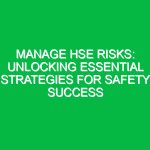Introduction
In the complex landscape of Health, Safety, and Environment (HSE) management, understanding the concept of management risk is paramount. Management risk refers to the potential for loss or adverse outcomes resulting from decisions made by management, particularly in the context of health and Safety practices. As organizations strive to maintain compliance with Regulations and ensure the well-being of their employees and the environment, effective management risk becomes a cornerstone of successful HSE strategies.
This article explores the intricate relationship between management risk and HSE, delving into the key components, methodologies, and Best Practices that can unlock sustainable success in managing health, safety, and environmental challenges. Through a combination of theoretical insights and practical examples, we aim to equip readers with the knowledge to navigate the risks inherent in their operational environments.
Understanding Management Risk in HSE
Management risk in the HSE context involves assessing and addressing the potential Hazards that could arise from managerial decisions. These risks can stem from various sources, including regulatory changes, operational practices, and employee behavior. Recognizing these risks is essential for organizations aiming to enhance Safety culture and environmental stewardship.
For instance, a manufacturing facility may face significant management risk if it neglects to update safety protocols in response to new regulations or fails to provide adequate Training for its workforce. Such oversights can lead to accidents, legal liabilities, and reputational damage, significantly impacting the organization’s bottom line.
Key Aspects of Management Risk in HSE
1. Risk Identification
The first step in effective management risk is identifying potential Hazards that could impact health, safety, and the environment. This process involves a comprehensive review of operational practices, historical incident data, and regulatory obligations. Techniques like job safety analyses and hazard assessments play a crucial role in this phase.
For example, a construction company may conduct a thorough site assessment to identify risks associated with equipment use, worker proximity to hazardous materials, and environmental impacts such as noise pollution. By proactively identifying these risks, the organization can take necessary Precautions to mitigate them.
2. Risk Assessment
Once risks are identified, the next step is assessing their potential impact and likelihood. This assessment helps prioritize risks, focusing resources on those that pose the greatest threat to health, safety, and the environment. Various models, such as qualitative and quantitative risk assessment techniques, can be employed to evaluate the severity and probability of identified risks.
For instance, a chemical manufacturing plant might assess the risk of chemical spills by considering factors such as the volume of hazardous materials stored, the frequency of spills in the industry, and the effectiveness of existing containment measures. This structured approach allows organizations to allocate resources effectively and develop targeted risk management strategies.
3. Risk Mitigation
Effective risk mitigation involves implementing strategies to minimize or eliminate identified risks. This can include engineering controls, administrative measures, employee training, and emergency response planning. The goal is to create a robust framework that not only addresses current risks but also adapts to emerging challenges.
For example, an oil drilling company may implement advanced leak detection systems to monitor pipelines and reduce the risk of spills. Coupled with regular employee training on emergency response protocols, these measures enhance the organization’s overall risk management capability.
4. Monitoring and Review
Management risk is not a one-time assessment; it requires continuous monitoring and review. Organizations must regularly evaluate the effectiveness of their risk management strategies, adapting to changes in regulations, operational practices, and external conditions. This ongoing process ensures that organizations remain vigilant and proactive in their approach to HSE management.
For instance, an organization might conduct annual audits of its safety protocols to identify areas for improvement. Such reviews can reveal gaps in training, outdated Procedures, or unforeseen risks, allowing for timely adjustments to the risk management framework.
Benefits of Effective Management Risk in HSE
Implementing effective management risk strategies within the HSE domain yields numerous Benefits for organizations. These include:
- Enhanced Safety Culture: A proactive approach to management risk fosters a culture of safety, encouraging employees to prioritize health and safety in their daily activities.
- Regulatory Compliance: By identifying and mitigating risks, organizations can more easily comply with legal and regulatory requirements, reducing the likelihood of penalties and sanctions.
- Improved Operational Efficiency: Effective risk management can streamline operations, reducing downtime caused by accidents and incidents.
- Reputation Management: Organizations that prioritize HSE management are often viewed more favorably by clients, stakeholders, and the public, enhancing their overall reputation.
Best Practices for Managing Risk in HSE
1. Leadership Commitment
Strong leadership commitment is vital for cultivating a culture of safety and effective risk management. Leaders should actively promote HSE initiatives, demonstrating their commitment through actions and resources allocated to safety programs.
A personal anecdote comes from a mid-sized construction firm where the CEO regularly participated in safety training sessions. This not only motivated employees but also communicated the importance of safety at all levels of the organization.
2. Employee Involvement
Engaging employees in the risk management process fosters a sense of ownership and accountability. Organizations should encourage feedback and participation in safety committees, allowing workers to contribute their insights on potential hazards and safety improvements.
For example, a manufacturing company that established a safety suggestion program saw a significant increase in employee participation, resulting in innovative solutions for common safety issues.
3. Training and Education
Comprehensive training and continuous education are essential for ensuring that employees are equipped with the knowledge and skills to recognize and mitigate risks. Regular refresher courses and workshops can keep safety practices top-of-mind.
Consider a case study of a mining Operation that reduced incidents by 40% after implementing a robust training program emphasizing hazard recognition and reporting protocols.
4. Use of Technology
Leveraging technology can enhance risk management processes. Tools such as incident reporting software, risk assessment applications, and environmental monitoring systems can provide real-time data and insights.
For instance, a logistics company used GPS tracking to monitor driver behavior, leading to a 30% reduction in accidents by identifying risky driving patterns and providing targeted training.
Regulations and Standards Impacting Management Risk
Understanding the regulatory landscape is crucial for effective management risk in HSE. Various regulations and standards, such as OSHA (Occupational Safety and Health Administration) guidelines in the United States, set forth requirements for Workplace Safety and environmental protection.
Compliance with these regulations not only mitigates legal risks but also enhances overall safety standards. Organizations must stay abreast of changes in regulations to ensure their risk management practices align with current legal expectations.
For example, after the introduction of stricter emissions regulations, a manufacturing facility implemented a comprehensive environmental management system to monitor and reduce its environmental footprint, demonstrating a proactive approach to compliance and risk management.
Conclusion
In summary, effective management risk is an integral component of successful HSE practices. By understanding the complexities of risk identification, assessment, mitigation, and continuous monitoring, organizations can navigate the myriad challenges associated with health, safety, and environmental management.
The benefits of implementing robust risk management strategies are significant, from enhanced safety culture and regulatory compliance to improved operational efficiency and reputation management. As the landscape of HSE continues to evolve, embracing Best Practices and regulatory requirements will be essential for organizations aiming to achieve long-term success in their risk management endeavors.
Ultimately, prioritizing management risk not only protects employees and the environment but also positions organizations for sustainable growth and resilience in the face of ongoing challenges. As you reflect on your organization’s approach to HSE, consider how effective management risk strategies can unlock new opportunities for success and safety.


